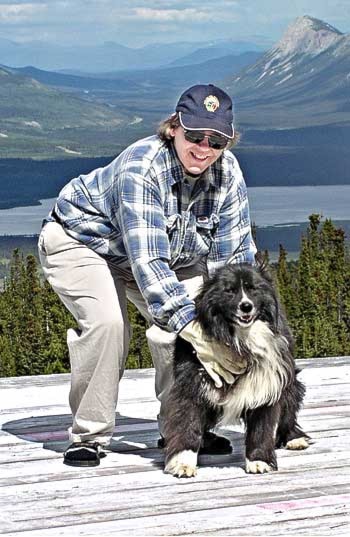Ione Christensen stood behind a projector in a tiny log-walled room at the MacBride Museum, speaking at length about life in the long-abandoned town of Fort Selkirk.
During the question and answer period, elderly tourists were mesmerized by their contemporary, a confident 77-year-old who could describe, in detail, skinning her first muskrat.
“How did you get from there to private school (on Vancouver Island)?” one man asked. He shook his head in disbelief as Christensen spoke about taking a boat to Whitehorse, the train to Skagway, and then another boat to British Columbia. Another man asked whether she had written her autobiography yet.
Bits and pieces, she said. But nothing’s finished yet.
In the meantime, Christensen, who has served as Yukon Commissioner and senator, is offering portraits of Yukon history through her eyes. The only child of an RCMP officer stationed in Fort Selkirk, she spent the latter part of the 1930s and most of the 1940s living in the community of a few dozen families.
And while the photos and anecdotes seem otherworldly, her reminiscences are relevant to today’s Yukon.
Her father, who received the Order of Canada for his work on the frontier, didn’t feel the same ire that Yukon RCMP feel these days.
“It was social policing back then,” she said.
People felt close to their cop. He was the only one in town. Christensen’s family home sometimes served as a jail. Her dad was a caretaker, a role specific for small-town policing.
“The policeman was the social worker, he was a medical person, he was the post master - he was everything,” she said.
“But today a policeman is a law enforcer. End of story.
“He’s just a law enforcer. And anyone who is an enforcer is just not that popular.”
Society has gone the route of splitting up caretaking roles into different departments, she said. That’s why it’s going to be very difficult to find a remedy for the recent spate of questionable incidents involving RCMP officers.
“These hearings that we’re having on policing - it’s going to be very hard to get the sort of soft and fuzzy policing we use to have, because enforcing laws was the last thing my father did.”
There was one murder in Fort Selkirk when Christensen lived there. Other than that, the crimes were few and mostly related to bad social conduct.
“First Nations couldn’t drink back then - it was prohibited,” she said. “But they could make homebrew.
“Father usually knew when there was some being made, because the store clerk would tell him someone was buying yeast and sugar. And he would wait for it to ferment and go find it.
“But sometimes they made it someplace else and they would bring it in. And if they got drinking, they would be disorderly.”
But even those incidences were tame affairs. Those arrested were usually released once they sobered up and would come back to be charged later on.
This made Fort Selkirk a gem among the boisterous roadhouse-riddled towns on the trails of the Klondike Gold Rush.
Places like Dawson City or Carmacks all had a reputation for the animosity between people, whether it was racial hatred or not.
“There always seemed to be somebody who didn’t get along with other people,” said Christensen. “That didn’t happened in Selkirk.
“I couldn’t remember someone saying, I’m not talking to so-and-so today. It just didn’t happen.”
The wild west culture of the gold rush and the traditional customs of the First Nations are often told in separate threads. But tales like Christensen’s focus on a harmonious Yukon culture.
“We were all dependent on each other,” she said.
“The stores, Taylor and Drury’s and Hudson Bay, were there because of the fur trade. If it hadn’t been for the First Nations’ trapping, those stores wouldn’t have been there because they were there to buy from the First Nations.”
“If it had just been a European community, they probably wouldn’t have had those stores.
“And the First Nations were dependent on my mother for medication, and the police to help them if there were problems.
“My father, when he went out, would have a First Nation person with him.”
Fort Selkirk was established as a small Hudson’s Bay post in 1848 by explorer Robert Campbell. The town grew as sternwheelers used the site at the confluence of the Yukon and Pelly rivers to restock
fire wood.
But after 100 years of going strong, a new invasion whipped Fort Selkirk off the map. The new Alaska Highway bypassed the town, and the river highway closed.
In 1949, the white families moved out.
“Everybody knew it was coming,” said Christensen, whose family moved to Whitehorse.
So did the First Nations. They were asked to move to Minto, “which was not a good idea,” said Christensen.
“They should have gone to Pelly, which they eventually did, because that was their home territory,” she said.
“They weren’t happy with that move.”
Christensen’s family, along with First Nations families, like the Horsfalls and the Van Bibbers, left Fort Selkirk to establish in other parts of the Yukon.
They went on to establish Yukon family dynasties, she said.
As a former public official, Christensen carries both the authority to speak for the Yukon, and the memories to describe it as a living person and not as a lecturer.
“There’s not enough public officials who have that background,” she said.
The Past is Present Historic Lecture Series continues with its next presentation Wednesday, July 14 at 1:30 p.m. with Grant Zuzula explaining Yukon paleontology. Go to macbridemuseum.com for a schedule of the presentations over the next few weeks.
Contact James Munson at
jamesm@yukon-news.com
